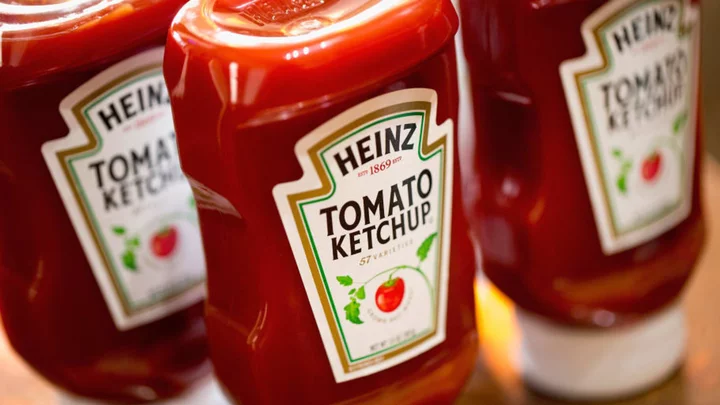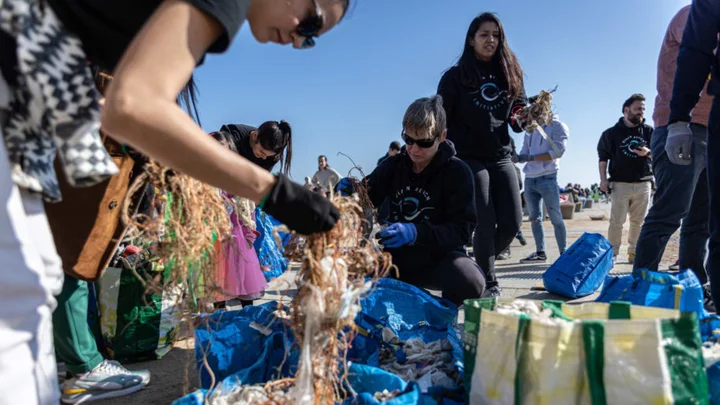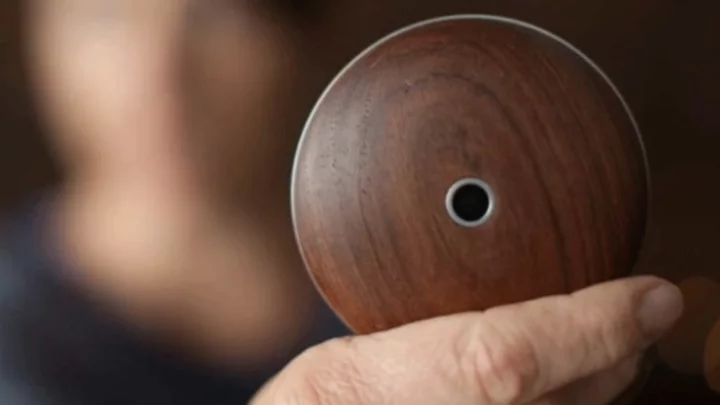There are weird facts and facts that are hard to believe—and then there are facts so strange all you can do is say, “huh?” From film adaptations bankrolled by the CIA to some intriguing insights into Russian space porn, these facts—adapted from an episode of The List Show on YouTube—are sure to have you scratching your head.
1. Casting for Quentin Tarantino’s Jackie Brown was done by Jaki Brown.
2. Casting for Lee Daniels’s The Butler was done by Leah Daniels-Butler.
3. The total weight of pumpkins produced in the U.S. each year is massive.
It’s equivalent to the weight of about 12.8 billion standard Charleston Chews.
4. In his will, William Shakespeare left his wife “my second best bed.”
5. Jurassic Park author Michael Crichton was taller than Michael Jordan.
Crichton, who also wrote Congo and The Andromeda Strain, clocked in at around 6 foot 9. The greatest basketball player of all time was around 6 feet, 6 inches. If you’re wondering, Crichton did play varsity basketball, but as far as we know Jordan has never dipped his toes into the waters of speculative science-fiction.
6. In the 10th century CE, King Harald Gormsson spearheaded the widespread introduction of Christianity in Denmark.
The king had a discolored, dead tooth that earned him a rather undesirable nickname: Harald Bluetooth. About a millennium later, Bluetooth technology was christened in his honor. As Intel’s Jim Kardach remarked, “King Harald … was famous for uniting Scandinavia just as we intended to unite the PC and cellular industries.”
7. Elijah Jefferson Bond, the first person to patent the Ouija board, has a Ouija board etched into the back of his gravestone to commemorate his legacy.
8. In late 1800s America, many cities and towns lacked green spaces to gather—so a fad started up of picnicking in cemeteries.
9. Around the same time, in England, people were afraid of being accidentally buried alive.
It’s not at all clear that this was an actual problem in need of a solution, but in any case, one soon arose. The “safety coffin” or “coffin alarm” was a way for a prematurely interred person to get the word out that they were still alive. Most of these devices used a bell or some other type of noisemaker to communicate between the coffin and people six feet over.
10. Departed fans of Atletico Madrid could have their ashes put in a specially designated area of Vicente Calderon Stadium.
When the team switched stadiums in 2019, the ashes were dutifully collected and reinstalled in the team’s new digs.
11. If you’d like to avoid being buried any time soon, maybe pick up the phone and make some dinner plans.
A study from Harvard University finds that having no friends can be just as deadly as smoking. Both affect levels of a blood-clotting protein that can contribute to heart attacks and strokes.
12. It was long rumored that Danish astronomer Tycho Brahe may have died from poisoning.
Some people even said the deed was done by his onetime assistant Johannes Kepler, who wanted access to Brahe’s data. In 2010, though, Brahe’s body was exhumed, and it was soon determined that there wasn’t a deadly level of mercury in his system, as previously thought possible. Instead, he may have expired from holding it in too long. This theory says that Brahe got a deadly bladder infection after his overly polite choice to not excuse himself from a royal banquet. Brings a new meaning to the phrase “when you gotta go, you gotta go.”
13. Just before his death in 1771, Adolf Frederick, King of Sweden, celebrated Fat Tuesday.
Fat Tuesday is a day when some observant Christians get their vices out of their systems before Lent begins. Adolf Frederick’s vices seem to have included gluttony: It’s said that he feasted on lobster, caviar, champagne, and 14 servings of a sweet roll then known as “hetvägg.” The extremely rich meal probably wasn’t directly responsible for his death, but it certainly didn’t help.
14. The biannual awards for excellence in obituary writing are called “the Grimmys.”
The conference organized by The Society of Professional Obituary Writers is called “ObitCon.”
15. NFL quarterback and commentator Steve Young’s great-great-great-grandfather was Brigham Young.
Also known as the second president of the Church of Jesus Christ of Latter-day Saints. Fun fact: Brigham Young once said of the Church’s founder, Joseph Smith, “[he] told me that the garden of Eden was in Jackson County, Missouri.”
16. Al Roker and Lenny Kravitz are distant cousins.
17. Roker once pooped his pants at the White House.
The incident occurred roughly a month after he had undergone gastric bypass surgery. Roker might have eaten something there that he shouldn’t have. As the beloved weatherman told Dateline’s Nancy Snyderman, “I pooped my pants. Not horribly, but enough that I knew.” The unfortunate event is actually a not uncommon side effect of gastric bypass. Roker didn’t let the incident get in the way of his time in our nation’s most hallowed home, though. He “threw out the underwear and just went commando.”
18. Shoe designer Manolo Blahnik once considered “toe cleavage” a “very important part of the sexuality of the shoe.”
He felt “you must only show the first two cracks.” Blahnik has since backtracked on this crack fact, though—In 2012, he said, “I’m tired of the whole toe-cleavage thing.”
19. Most dermatologists do not recommend an activity known as “perineum sunning.”
This Instagram-fad suggested that sun exposure to the area between the genitals and the anus would confer incredible benefits on participants, from improved focus to enhanced health and longevity. Sunshine and Vitamin D are, to be sure, good in moderation, but please wear sunscreen, and feel free to keep your underwear on.
20. The Texas Horned Lizard can squirt blood out of its eyes.
It’s a defense mechanism.
21. Sloths can hold their breath underwater for 40 minutes.
That’s actually considerably longer than a dolphin.
22. Many frog species can breathe through their skin.
Though they do have lungs, when their skin is moist this unique ability provides another method to absorb oxygen.
23. Frogs also shed their skin occasionally.
Instead of leaving it behind, though, they “push the shedding skin into their mouth and eat it,” in the words of Seattle’s Burke Museum.
24. All kittens are born with blue eyes.
At around a month a half, the kitties start producing melanin, causing the eyes of many breeds to darken.
25. Maryland’s state motto, translated from the original Italian, is “manly deeds, womanly words.”
26. Maryland’s official sport is jousting.
It was the first state in the country to adopt an official sport.
27. In 1962, contractors who were looking to design spacesuits for NASA wrote to officials at the Tower of London.
They wanted insights into armor that had been designed for King Henry VIII, which the Tower held in its collection. The one-time Tudor King had to have full protection while remaining mobile when engaged in games of foot combat. At least one of the spacesuit developers apparently felt this balance between protection and mobility was similar to the challenges his team faced and requested photographs and “details of the various joints” that comprised the armor.
28. When NASA began accepting women astronauts into its program, engineers at the agency designed a makeup kit to go into space.
29. They also asked astronaut Sally Ride if 100 was “the right number” of tampons for a one-week flight.
30. Green potatoes can kill you.
The green color cast some old potatoes develop is an indirect indication of high concentrations of the toxin solanine. Though solanine poisoning is rare today, there are documented incidents of people dying from toxic potatoes. If in doubt, it’s probably best to throw out any green potatoes.
31. Sage Werbock, a.k.a. “The Great Nippulini,” earned a Guinness world record for pulling a nearly 1000 kilogram vehicle 20 meters by his nipples.
According to his website, Werbock has hung up his nipples and no longer performs publicly.
32. From 1952 to 1957, the CIA launched balloons that carried copies of Animal Farm into Iron Curtain countries.
The balloons were launched from West Germany and sent into countries including Poland, Hungary, and Czechoslovakia. George Orwell’s allegorical novella, often read as a criticism of Stalinist communism and the results of the Russian Revolution, was banned in those countries. The idea behind the operation was for Orwell’s satirical ideas to get into the hands of people who might then start to question authorities and the Communist Party line.
33. The CIA also bankrolled the 1954 Animal Farm cartoon movie.
34. Robert Louis Stevenson may have written Dr. Jekyll and Mr. Hyde under the influence of medicinal cocaine.
The author, who was sickly all his life, wrote the story in just a few days.
35. Turkeys (the birds) were named after Turkey (the country).
Centuries ago, the English began to import the helmeted guinea fowl. The people who ate the poultry evidently didn’t know it was from Africa. Because it was imported to Europe from merchants in Turkey (now Türkiye), the English believed the birds were also Turkish. According to one account of its etymology, when the Spanish arrived in the New World, they encountered a new bird that was delicious and it too was soon being imported to Europe. The English got it confused with the turkey they had been enjoying. Eventually, the name stuck to the New World bird.
36. Nineteenth-century artist Edward Burne-Jones held a funeral for a tube of paint.
He had found out that the “mummy brown” paint he was using was made from actual ground-up mummies, so he held a funeral for the tube in his back garden. A young Rudyard Kipling was in attendance.
37. Each year, 40,000 tons of space dust settles in Earth’s atmosphere and surface.
It’s thought that the dust comes mostly from relatively nearby comets and asteroids, though more recent research suggests that some of it could come from much farther, including the Kuiper Belt, which starts at a distance about 4.3 billion kilometers from us.
38. Earth’s plates move at about the same rate as growing fingernails.
39. Scotland’s national animal is the unicorn.
40. A number of other countries share the dragon as their national animal.
Translated into English, in fact, Bhutanese leaders are known as “Dragon Kings.”
41. Novelist Patricia Highsmith kept approximately 300 snails as pets and regularly carried the critters in her handbag.
According to a biography, the Talented Mr. Ripley author would bring her little friends out if she got bored at dinner.
42. The Goodyear Blimp is the official bird of Redondo Beach, California.
43. Barry Manilow wrote State Farm’s “Like a Good Neighbor” and Band-Aid’s “I Am Stuck On Band-Aid” jingles.
44. Elvis Presley won three Grammys—none of them for rock music.
He got two for Best Inspirational Performance and one for Best Sacred Performance.
45. Some species of requiem sharks can grow and shed tens of thousands of teeth over the course of their lives.
46. Some types of sea slugs can go through hundreds of thousands of radulae over the course of their lives.
Radulae are essentially the gastropod version of teeth, which sit inside their mouths.
47. If you blink while on a plane traveling 500 mph, your eyes are closed for about 250 feet.
48. The average person blinks around 6 million times a year ...
49. ... meaning their eyes are closed, while blinking, for around 10 percent of the total time they’re awake.
50. In 2021, a 67-year-old man in Thailand took deworming medicine for gastrointestinal distress.
In the horrific words of Mashable Southeast Asia, he “woke up the next morning to find an 18-meter-long tapeworm already exiting his rectum.”
51. Some species of tapeworms have specialized anatomy to hold on to animal intestines.
Some tapeworms use spines or retractable hooks to get a grip, while others have suction cup-like suckers to hold on, even as the muscles of their hosts contract during digestion.
52. Kevin Williamson created the show Dawson’s Creek and wrote the screenplays for Scream, Scream 2, and Scream 4.
53. Johnny Cash’s “A Boy Named Sue” was written by beloved children's author Shel Silverstein.
54. Silverstein penned a satirical comic for the military’s Stars and Stripes magazine in the 1950s.
Afterward, he was warned not to make fun of army officers‚ instead, he was told, his criticism should be limited to civilians and animals.
55. The average person shares a birthday with about 20 million other living people.
56. In a room with 75 people, there’s an over 99.9 percent chance that two will share a birthday.
57. For a period in the late 1800s, it was believed that milk was an adequate replacement for human blood in the body.
After one human milk transfusion gone wrong, the patient had to be resuscitated with a combination of morphine and whiskey.
58. A hotel in Australia once offered an interesting treatment for rheumatism.
Whenever a dead local whale was spotted, the hotel gave patients the opportunity to lay inside the carcass for a couple of hours, thinking it would reduce inflammation. The short-lived, so-called treatment was apparently “discovered” when a drunk man “took a header into the decomposing blubber” of a recently deceased cetacean and came out rheumatism-free.
59. Annie Withey and Andrew Martin developed Smartfood popcorn, which they sold to Frito-Lay in 1989.
Soon after, the pair introduced their second successful cheese-dust-based offering: Annie’s Mac & Cheese.
60. Jeannette Rankin was elected to the House of Representatives in 1916.
That was four years before the 19th Amendment, which granted women the right to vote, was passed.
61. For Kazakhstan’s first 27-plus years as an independent country after the dissolution of the Soviet Union, it had a single president.
His name was Nursultan Nazarbayev.
62. In 2019, the country’s capital, Astana, was renamed to Nur-Saltan.
It was changed back in 2022.
63. In most of the United States, cannibalism isn’t explicitly outlawed.
The exception is Idaho, and even in the 49 other states you’d likely be breaking other laws in the process.
64. The Denver-based newspaper Westword looked into the illegal body trade in Colorado back in 2018.
They found that one purveyor charged $200 for an elbow.
65. According to William Seabrook, an early 20th-century journalist who claimed to eat human meat, it tasted “like good, fully developed veal.”
66. Around 125 billion Jenga blocks would fit inside Louisiana’s Superdome, by volume.
67. Hippos can run up to 30 miles per hour for short spurts.
It’s thought that they kill hundreds of people each year.
68. Though hippos are well-adapted to the water, they don’t really swim.
The animals can actually sleep underwater, pop up for a breath, and sink back down without waking up.
69. More than 100,000 annual deaths are indirectly attributable to freshwater snails.
Some species of the gastropod carry a deadly parasite which they can pass on to humans. The resulting disease has been informally dubbed “snail fever.”
70. A 58-year-old man has about a 1 percent chance of dying within the next year.
That’s according to the United States’s Social Security Administration’s actuarial life table.
71. An ostrich kick can kill a lion.
The big birds have long, sharp toenails and they’re stronger than those rather spindly-looking legs might have you believe. According to a piece by Randy Sell of North Dakota State University, “A mature ostrich is capable of delivering a kick of up to 500 psi.” That’s around the same pressure delivered by a professional bantam weight boxer.
72. The website Wikihow has an entry on “how to survive an encounter with an ostrich.”
It has instructions on what to do “if you have a gun and need to use it,” and features some incredible drawings of human-ostrich combat.
73. There have been reports of ostriches raised on ranches seemingly being sexually attracted to humans.
Or at least the birds no longer saw other ostriches as potential mates.
74. Johnny Cash once got attacked by an ostrich.
The bird’s name was Waldo, and according to Cash, “I got off lightly. All he did was break my two lower ribs and rip my stomach open down to my belt.”
75. Russian officials denied rumors that two cosmonauts had sex during a mission.
But one half of that pair, Dr. Valery Polyakov, did mention some “‘colorful’ movies” that Russian officials sent men in space to help them regain typical sexual functioning after a long (presumably celibate) mission.
76. Polyakov also apparently received suggestions from unnamed sources to use some kind of sex doll in space.
He came out against that idea, partially on the grounds that an astronaut with such equipment at his disposal might develop something he called “doll syndrome.”
77. The “scold’s bridle” was a thing.
This rather horrifying item first appeared in the 16th century and was “used to hurt and humiliate women whose speech or behaviour was thought to be too offensive or unruly,” in the words of the British Library.
78. In the 19th century, naturalist Peter A. Browne collected albums full of hair—including samples from noteworthy Americans
Browne had hair from author James Fenimore Cooper’s locks and 13 of the first 14 U.S. presidents (it seems that he never got his hands on any strands from Millard Fillmore). Sheep and lion locks also made it into the collection.
79. A leading cause of dandruff seems to be a particular type of fungus.
It’s known as Malassezia. So if you find the itchiness and flaking uncomfortable, maybe meditate on the fact that there’s fungi thriving on your scalp.
80. There are mites living on your face.
They’re also eating, pooping, and reproducing on your face.
81. There are around as many microbial cells in your body as … your body.
The average human is made up of about 30 trillion human cells, and 39 trillion microbial cells of various types. Because the microbes are so small, they only account for about 1 to 3 percent of a person’s body mass.
82. In 1978, a serial killer appeared as a contestant on The Dating Game.
Unbeknownst to the show’s producers or that episode’s bachelorette, contestant Rodney Alcala had already committed at least four murders at the time. He’d eventually be convicted of more than a half dozen homicides, but that day he was selected as the winning bachelor for a date that luckily never transpired.
83. In 1589, a German man named Peter Stumpp said that he had made a pact with the devil to get turned into a werewolf.
Stump killed 16 people, including 13 children—one of whom was his own son. He supposedly ate his own child’s brain. And from there it somehow gets even worse.
84. There were actually hundreds of werewolf trials in Germany.
It sounds like a lot until you compare it to the tens of thousands of executions for supposed witchcraft that happened in Germany during the same era.
85. The Donner Party tragedy led to a food development.
Their plight ended with the some of desperately hungry survivors resorting to cannibalism of the non-homicidal nature—and helped lead Gail Borden to develop shelf-stable condensed milk.
86. Before that invention, Borden had tried introducing the somewhat less successful “condensed meat.”
87. King Louis XIV was known as the Sun King, but he once dealt with an issue where the sun don’t shine.
He had an anal fistula, which in the words of the UK’s National Health Service website, is “a small tunnel that develops between the end of the bowel and the skin near the anus (where poo leaves the body).” Fistulas can cause discomfort and make sitting difficult, so Louis sought out treatment to alleviate his royal pain in the butt. To prepare for the procedure, surgeon Charles-François Félix practiced on dozens of healthy commoners. It’s thought that many of these test patients died.
88. After the surgery, it supposedly became fashionable, in the French Court, to have a fistula.
Some people actually put fake fistulas made of bandages around their butts. This was known as “le royale.”
89. One of Louis XIV’s mistresses, Madame de Montespan, ended up embroiled in a controversy known as “The Affair of the Poisons.”
It was essentially a series of witch trials centered around Madame Catherine Monvoisin, also known as La Voisin, a potion maker who had the pejorative sobriquet “the witch of Paris.” La Voisin’s partner said that the royal mistress had only achieved her position through the use of special potions. La Voisin was eventually killed for her alleged crimes. Her daughter then outlined an even more outlandish story about Montespan engaging in the dark arts and even drinking baby’s blood. Montespan, for her part, ended up retiring to a convent.
90. Fourteenth-century royals once hosted an all-too-literal “burning man.”
A banquet hosted by Queen Isabeau of Bavaria featured a group of dancers in apparently flammable outfits. When the Duke of Orleans got too close with a lit torch, it set off a fire that resulted in the deaths of four men.
91. King Christian VII of Denmark’s “uncontrollable urge to masturbate [was] a popular subject within the royal court.”
That’s according to Denmark’s Copenhagen Post, which added that “the gossip was ripe about the time the king during a royal feast in Christiansborg entered the room with his pants around his ankles.”
92. Jim Steinman wrote “It’s All Coming Back to Me Now,” which Celine Dion made famous.
Steinman—who was a frequent collaborator of Meat Loaf’s—had an interesting perspective on the power ballad. On his personal website, he noted that he wrote it “under the influence of Wuthering Heights” and called it “an erotic motorcycle.”
93. Over a billion tons of food are thrown away each year.
That’s about a third of all food produced for human consumption.
94. According to the Food and Agriculture Organization of the United Nations, that includes over 3 trillion apples.
95. There’s a reason that Pringles packaging labels the snack as “potato crisps” rather than “chips.”
Rather than slicing potatoes and frying them up, Pringles are a bit of a franken-chip made up of dehydrated potato along with wheat starch, rice four, and other ingredients. They actually are only 42 percent potato. Back in 1975, the FDA ruled that Pringles could only be labeled “chips” if they also prominently mentioned the dried potatoes. The company ultimately decided to call them “crisps” here in the States.
96. Protor & Gamble spent a lot of money making Pringles.
According to a New York Times piece from 1975, “It’s believed Procter & Gamble … spent 10 years and $70 million to research, develop, manufacture and market its first Pringles.” Using the U.S. Bureau of Labor Statistics Consumer Price Index Inflation calculator, that’s equivalent to about $12 billion dollars today.
97. In 2005, a man in Bulgaria was found by doctors to have a .914 blood alcohol content.
That means that almost 1 percent of his blood stream was alcohol. That’s more than 18 times the legal limit in the state of Utah, incidentally, and more than twice the level generally considered fatal. Nevertheless, the man survived and was even awake and talking to police.
98. More than 40 percent of people in one study had a longer second toe than “big toe,” according to a 2010 study.
This condition is known as “Morton’s toe.”
99. In the space between the Sun and Pluto, you could fit about 400,000 Earths back to back.
100. Pancakewise is a real word.
It means “towards or for a pancake.”
This article was originally published on www.mentalfloss.com as 100 Facts That Will Make You Go “WTF”.









